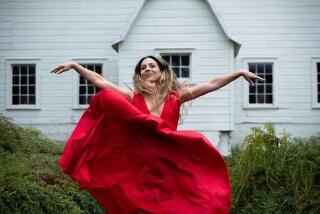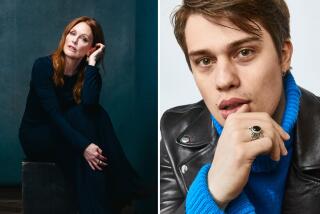Review: ‘Moon and Me,’ from a mind behind ‘Teletubbies,’ has a dreamy charm
- Share via
Back at the end of the last century, the Teletubbies were born — four brightly colored, plush baby-things, each with a video screen on its stomach and an antennae atop its head. They lived (on television, in a BBC-produced show called “Teletubbies”) in a dome in a verdant valley, with real rabbits and a baby-faced sun, played, ate tubby custard and led well-regulated lives between getting out of and going to bed.
“Teletubbies” co-creator Andrew Davenport has a new show, called “Moon and Me,” which recently made its American debut on the premium cable network Universal Kids. (In between came a series called “In the Night Garden,” with which I’m not familiar.) Like “Teletubbies,” — which ran originally from 1997 to 2001 and was revived in 2015 and is still doing its work in the world — “Moon and Me” is targeted to the very young. It’s slow and repetitive and otherworldly, qualities that purportedly made the original “Teletubbies” a favorite of club kids coming down after a long night of EDM, but which also appealed to … me. And I have the stuffed Po to prove it.
“Moon,” which originates from the BBC’s children’s channel CBeebies, is a night show, obviously, where “Teletubbies” is very much about the day. And where earlier series featured grown humans gamboling in costume, the new one is made as puppet animation, the most magical of animated mediums. Crafted in three actual dimensions, in materials like fabric and clay and wood, it reads on camera as real, because it is. You want to reach in and touch it.
Each episode begins with a child’s voice: “Hush, hush, says the moon. It’s time to go to sleep.” She puts her dolls to bed in a dollhouse, with other elements — a couple of paper crowns, say, or a toy carousel — that will play a part in the story to come.

“Moon, can we have a story?” asks the child.
“A story,” answers the moon, whose voice belongs to the familiar British actress Nina Sosanya (“Nathan Barley,” “Last Tango in Halifax,” “Killing Eve,” “Good Omens” and lots more). “What a good idea.”
When the lights go out, a doll named Pepi Nana, who bears a resemblance to the human child, gets out of bed and writes a letter to the Moon. Moon Baby, who has a royal presence and lives in a cavern there, receives it, flies down to Earth and wakes the dollhouse with his lunar glow.
Living alongside Pepi Nana are Mr. Onion, an onion; Colly Wobble, a sort of clown; Sleepy Dibillo, a narcoleptic rabbit; Lambkin, a lamb on wheels; and Little Nana, a very tiny doll, who sleeps in a matchbox. (There is also Lily Plant, who stays put.) Sosanya sometimes speaks their dialogue, in complete sentences, but left to their own devices most tend to repeat a a single phrase or sound. Pepi Nana says “Tiddle toddle,” Mr. Onions says “Onions,” Little Nana says “Poop poop,” Lambkin goes “baaa.”
When everyone is awake, Moon Baby takes out a magical thumb piano, plays something that sounds a bit like the theme to John Huston’s “Moulin Rouge,” and they all go to Storyland, a sunlit countryside where the characters will act out a story. It is meta, in its way.
After the story, there is a song. My favorite, which is sung by Michael Bublé, is about a horse in the house: “If there were a horsey in the house/The horsey would be bigger than the house.”
Then comes tea. Everyone gets sleepy and goes to sleep. Moon Baby scoots home moonward.
If “Moon and Me” lacks the psychedelic weirdness of “Teletubbies” and is based in an idea that has been around forever — toys coming to life while the humans sleep — it has its own outside charm. In part it’s because it’s actually foreign, a British import, and its children’s television has always looked different from ours, less hectic, more pastoral; “Moon and Me” is not too many stops down the track from “Thomas & Friends” (adapted for American audiences as “Shining Time Station”).
The show is what might be called pre-psychological; it has an amniotic warmth. There are no lessons; there is no conflict, no challenge greater than not quite being able to reach something. There is no judgment other than that things are very nice. Decisions are made, and always approved. Who doesn’t need that from time to time? Life can’t be all dragons and regicide.
“Once upon a time,” says the Moon, for example, “Mr. Onion had a bridge. (“Onions,” says Mr. Onion.)
“I will cross my bridge,” says Mr. Onion. (He should have added, “When I come to it,” but to be fair, he was already there.) He crosses; he crosses back. Pepi Nana wants to cross the bridge; not to be spoilery, but she gets across. (She does a little tap dance on it, friskily.) It is that kind of high-watt drama. It’s not a Billy Goats Gruff situation. It’s not a dangerous bridge. It’s just “step, step, step.”
“Mr. Onion loves his bridge,” says the Moon. “And that is the end of the story.”
At the same time, “Moon and Me” isn’t simple; there are layers of play and reality that, if we must be psychological about it, might be said to mirror the porous, amorphous world of early childhood, with its indistinct layers of play, dreams and reality. When the characters sit down to tea, back in the toy house after an adventure in which tea was taken, Little Nana objects, “We’ve already had tea.”
“That was tea in a story,” Pepi Nana replies. “This is pretend tea. It’s much more proper.”
------------
‘Moon and Me’
Where: Universal Kids
When: 8 a.m. weekdays
Rated: TV-Y (suitable for young children)
Follow Robert Lloyd on Twitter @LATimesTVLloyd
More to Read
The complete guide to home viewing
Get Screen Gab for everything about the TV shows and streaming movies everyone’s talking about.
You may occasionally receive promotional content from the Los Angeles Times.







